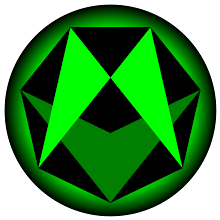I'm going to try to do 52 materials this year. Some of these might be longer than others, but I hope all of them are at least somewhat interesting.
The first interesting material post is about quartz. It's a material that most people have heard of, since in the modern world it is actually quite commonly used in quartz watches.
Quartz, chemically, is SiO2, Silicon Dioxide. This same ratio of atoms can be arranged in a variety of slightly different arrangements, the most common of which are α-quartz and β-quartz. They are very slightly different in how the tetrahedrons are arranged, and in general will look the same macroscopically.
However, this clear, six-sided "superman" crystal is fairly rare to see; about the closest that is common is the crystals in geodes, available wherever tourist trinkets are sold.
Chemically pure quartz is clear, but if there are bubbles of gas or liquid, it can be smoky white. If there are other impurities, the color can vary widely. In fact, several "different" gemstones are just different colors of the same mineral, and quartz is no exception.
 Citrine,
Citrine, amethyst,
amethyst,
and rose quartz are all the same underlying material. Even further, Chalcedony, Agate, Onyx, Jasper, Tiger's Eye, and Carnelian are all essentially
 quartz, with different sets of impurities and a lack of macrocrystaline form.
quartz, with different sets of impurities and a lack of macrocrystaline form. But the name quartz is probably most famous for being used in clocks, and this is due to one of its unique properties: piezoelectricity. When a voltage is applied to the crystal, it deforms, and when it deforms, it produces a voltage. Because of this, if a piece of quartz is made to "ring" or vibrate at its natural frequency, it produces regular electronic output that can be used to regulate a digital watch. Inside every cheap digital watch is a tiny tuning fork of quartz.
The use of quartz oscillators is a foundational technology to our modern world. Precise timing is at the heart of most of the advances in science, and cheap quartz resonators allowed reliable radios and computer timing circuits to proliferate.
As practical as quartz's piezoelectric property is, there's a much less practical, but far more awesome property that quartz has: triboluminescence. Triboluminescence is the awesome and not particularly well-understood process where mechanical stress produces light directly, not from incandescence due to friction heating. Although several common crystals have this property, the effects are often unnoticed because the light produced is very dim. As noted in the wikipedia article on triboluminescence, some American Indians used the triboluminescence of quartz to make flashing rattles used in nighttime dances. Triboluminescence is also behind the very interesting story of the x-rays from scotch tape in a vacuum story.
So, simple quartz is able to produce both light and electricity by being smashed. How cool is that?

Wow - that is pretty crazy. I knew that quartz was used in watches but I never knew what it does. How fantastic to find something so precise and perfect in a detail so small.
ReplyDeleteI looked at the x-ray video too. So fantastic. I would love to see how that concepts develops as we know more about it.
ReplyDelete